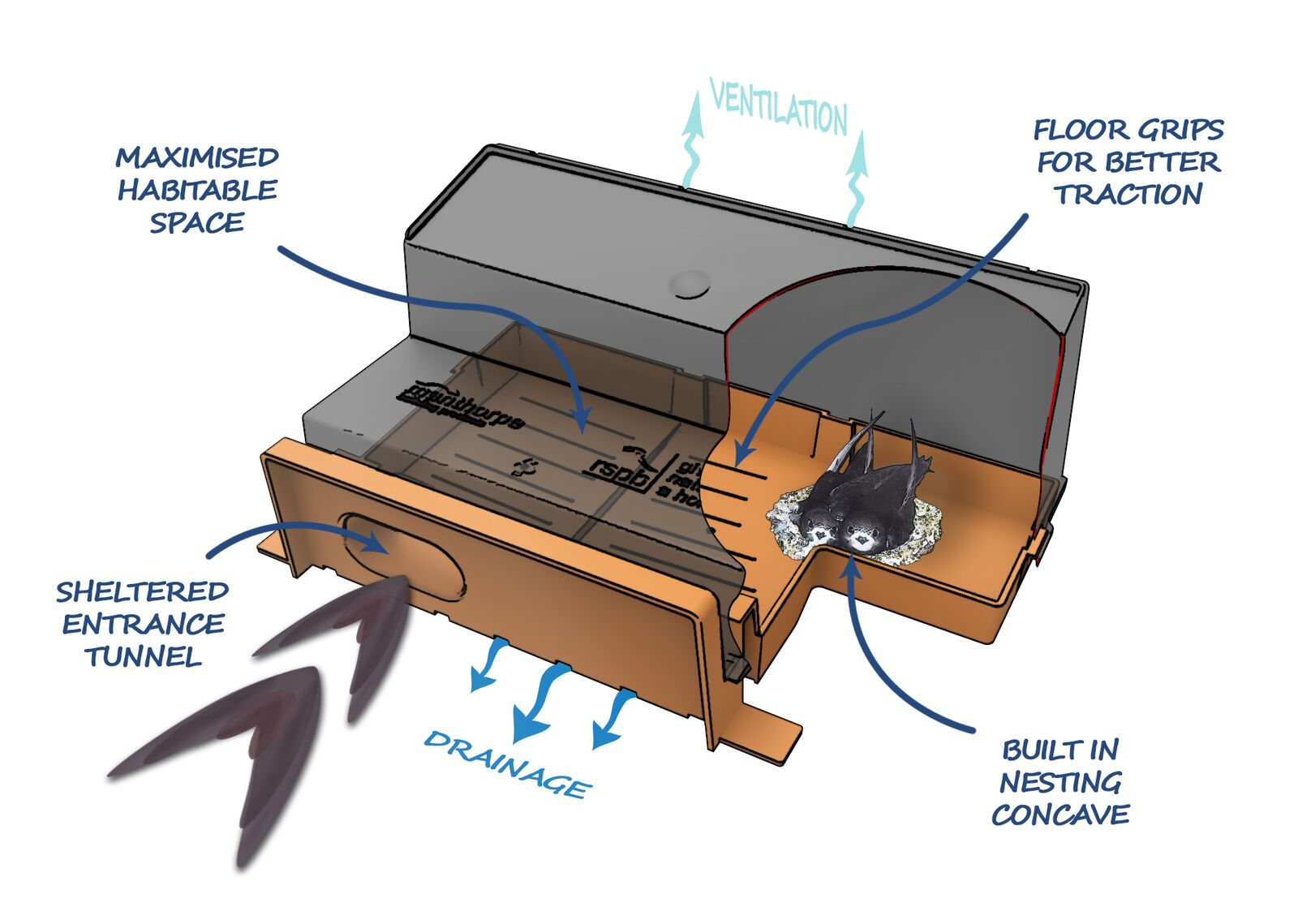Swift brick
Swifts are plain, sooty brown, medium-sized aerial birds that breed in the UK but winter in Africa.
The Royal Society for the Protection of Birds (RSPB) report that the number of swifts has almost halved in 20 years down from almost 150,000 breeding pairs arriving in the UK to less than 90,000. It is thought that this decline is in part due to a reduction in potential nesting sites as buildings are renovated or demolished.
Nesting accommodation for swifts built in to buildings is preferable to accommodation retrofitted onto the outside. Swift bricks provide a mechanism for building nesting accommodation for swifts into brickwork. They are available from a range of suppliers, including from Action for Swifts, and can be embedded into walls below the eaves. Ideally swifts brick should fit within a multiple of standard UK brick sizes to make them easier to install.
Swift bricks typically encroach into the wall cavity, or even span the cavity. If they are placed under the eaves, or under a fascia boards, this is generally not be a problem, however lower locations may need to incorporate a cavity tray to prevent water penetration. Swift bricks should not overheat on south-facing walls, but if they have a thin front wall, they should not be placed in the sun, but should be sheltered under the eaves.
In 2016, Manthorpe Building Products, RSPB and Barratt Homes collaborated on the creation of a new swift brick, designed to be easily incorporated into new homes. 900 will be fitted at the Kingsbrook development in Aylesbury.
Michael Finn, group design and technical director at Barratt Developments said, “The bricks are an industry first – they are fully drained, ventilated and are unobtrusive, by matching the colour of the bricks. They also help nurture chicks by giving them room to stand when they hatch. Crucially too, they are much, much cheaper than any other swift brick on the market, which will help their uptake. We actively want other developers to use the brick so we can all help build swift populations. It’s a great example of how we are working together with the RSPB and the wider industry to support nature.”
[edit] Related articles on Designing Buildings Wiki
- Bats.
- Bat roost box.
- Bee brick.
- Biodiversity offsetting.
- Biodiversity.
- Brick.
- Ecological Impact Assessment EcIA.
- Ecological network.
- Ecological survey.
- Ecologist.
- Eco-Management and Audit Scheme.
- Environmental impact assessment.
- Environmental plan.
- Environmental policy.
- Great crested newt.
- National nature reserves.
- Natural England.
- Preliminary ecological appraisal.
- Protected species.
- Swift box.
- Types of brick.
Featured articles and news
A change to adoptive architecture
Effects of global weather warming on architectural detailing, material choice and human interaction.
How big is the problem and what can we do to mitigate the effects?
Overheating guidance and tools for building designers
A number of cool guides to help with the heat.
The UK's Modern Industrial Strategy: A 10 year plan
Previous consultation criticism, current key elements and general support with some persisting reservations.
Building Safety Regulator reforms
New roles, new staff and a new fast track service pave the way for a single construction regulator.
Architectural Technologist CPDs and Communications
CIAT CPD… and how you can do it!
Cooling centres and cool spaces
Managing extreme heat in cities by directing the public to places for heat stress relief and water sources.
Winter gardens: A brief history and warm variations
Extending the season with glass in different forms and terms.
Restoring Great Yarmouth's Winter Gardens
Transforming one of the least sustainable constructions imaginable.
Construction Skills Mission Board launch sector drive
Newly formed government and industry collaboration set strategy for recruiting an additional 100,000 construction workers a year.
New Architects Code comes into effect in September 2025
ARB Architects Code of Conduct and Practice available with ongoing consultation regarding guidance.
Welsh Skills Body (Medr) launches ambitious plan
The new skills body brings together funding and regulation of tertiary education and research for the devolved nation.
Paul Gandy FCIOB announced as next CIOB President
Former Tilbury Douglas CEO takes helm.
UK Infrastructure: A 10 Year Strategy. In brief with reactions
With the National Infrastructure and Service Transformation Authority (NISTA).
Ebenezer Howard: inventor of the garden city. Book review.
Airtightness Topic Guide BSRIA TG 27/2025
Explaining the basics of airtightness, what it is, why it's important, when it's required and how it's carried out.























Comments
Will bricks be removable so that old material can be cleared out to prevent infection
https://ww2.rspb.org.uk/birds-and-wildlife/bird-and-wildlife-guides/ask-an-expert/previous/reuse.aspx